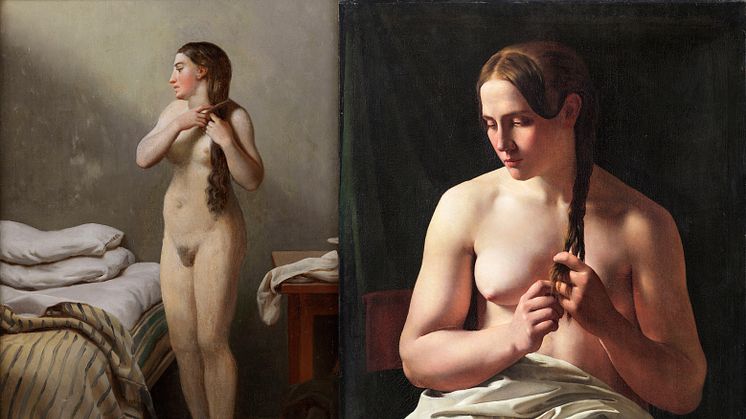
Press release -
New acquisitions: Two nudes and an interior by Eckersberg and L.A. Smith
Nationalmuseum has acquired a nude by Christoffer Wilhelm Eckersberg, a central figure in the art history of the Danish Golden Age. Eckersberg renewed a traditional genre by painting nudes in natural daylight, such as the acquired work. Nationalmuseum has also acquired a second nude and an idyllic interior scene of a mother and child by a window, both painted by Eckersberg’s pupil Ludvig August Smith.
Christoffer Wilhelm Eckersberg (1783–1853) was appointed as a professor at the Royal Danish Academy of Fine Arts in Copenhagen in 1818, after studying abroad under Jacques-Louis David and other teachers. In turn, he became the teacher of a whole generation of successful artists during the period known as the Danish Golden Age (c. 1800–50). Eckersberg was a devoted teacher who showed great concern for his pupils, both academically and in a wider sense, even becoming a sort of father figure to some of them.
One of the main components of artistic education at the Academy involved drawing and painting from life models. The idea was to familiarize students with the structure and musculature of the human body, so that, as trained artists, they could depict figures in an anatomically correct way when painting detailed historical or biblical scenes. The Academy in Copenhagen did not allow female models to pose nude until 1833; before that, only male models were used. For many years, students painted life models in the evenings, by the light of naked flames, but in 1822 the Academy decided that they would be allowed to paint in natural daylight in future.
The two recently acquired nudes, portraying female models, are fine examples of mastery of the effects of daylight. To ensure optimal lighting conditions, Eckersberg moved a painting course focused on female models to the summer months from 1839 onward. Thanks to the painter’s detailed diaries, we know the identities of each summer’s models and students. The model for this Eckersberg painting, seen standing beside a bed and combing her hair, has apparently not been identified previously. On comparison with other works, however, she appears identical to Florentine, who modelled in the summers of 1840 and 1841. The piece is also a fine example of another way in which Eckersberg renewed the genre in Denmark: by portraying the model in an everyday setting, rather than having her pose like a classical sculpture.
Ludvig August (L.A.) Smith (1820–1906) attended Eckersberg’s summer course for several years. The model for his painting, Cathrine Nielsen, was hired in 1839. The work is a uniquely fine example of how the sharp summer daylight enables the artist to bring out the subtlest effects of the play of light and shadow on skin. The rounded shapes have acquired a markedly sculptural appearance. A painting by Eckersberg of the same model, Cathrine Nielsen, very similar to Smith’s, is now in the Louvre.
Nationalmuseum has also been fortunate enough to acquire another work by Smith, an interior scene painted in 1853. This work is an exquisite example of the delicate manner of painting of Danish Golden Age, typifying the intimate, domestic scenes popular at the time. Smith reflects this in his depiction of the room with the street view unfolding beyond the window.
Nationalmuseum’s purchase of these works has been made possible by a generous bequest from the Wiros Fund. Nationalmuseum has no budget of its own for new acquisitions, but relies on gifting and financial support from private funds and foundations to enhance its collections of fine art and craft.
Press contacts
Carl-Johan Olsson, Curator, carl-johan.olsson@nationalmuseum.se, +46 8 5195 4324
Hanna Tottmar, Press Officer, hanna.tottmar@nationalmuseum.se, +46 767 234632
Caption
Christoffer Wilhelm Eckersberg, Study of a Model; Ludvig August Smith, Woman Plaiting Her Hair, 1839. Photo: Linn Ahlgren/Nationalmuseum.
Categories
Nationalmuseum is Sweden’s premier museum of art and design. The collections comprise older paintings, sculpture, drawings and graphic art, and applied art and design up to the present day. The museum building is currently under renovation and scheduled to open again in 2018. In the meantime, the museum will continue its activities through collaborations both in Sweden and abroad as well as temporary exhibitions at the Royal Swedish Academy of Fine Arts, Fredsgatan 12 and Nationalmuseum Design at Kulturhuset Stadsteatern in Stockholm. Nationalmuseum has partnerships with Svenska Dagbladet and the Grand Hôtel Stockholm, and acknowledges the support of FCB Fältman & Malmén.

